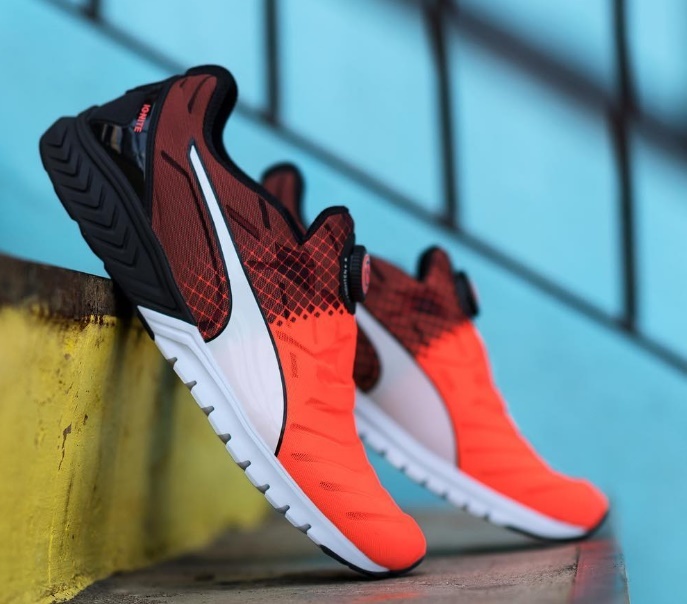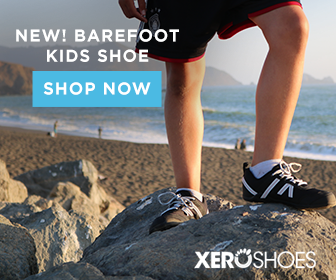Unlike heel strike running, which directly causes knee injury, the evidence is overwhelming proving that forefoot running completely protects the knee from injury by dramatically reducing high stress and impact-loading at landing.
To further safeguard the knees when running, in addition to forefoot striking, avoid wearing traditional running shoes because they’re typically too narrow and stiff, which was found to increase damaging rotational and torsional forces on the knee as compared with minimalist running shoes.


A 2015 study in the Scandinavian Journal of Medicine & Science in Sports and Exercise, discovered that running shoe stiffness in the longitudinal (lengthwise) direction and at the heel significantly increased torsional stiffness on the foot and ankle which in turn caused increases in straining rapid heel motions during the stance phase of running.
The researchers underscored that the unusual heel motions imposed by shoe stiffness also profoundly altered the kinematic chain up the lower leg during running. This means that stiff running shoes alters ankle, knee and hip joint position out of neutral line during running which increases an assortment of injurious stressors on the leg, including the knee.
Worse still, the researchers also found that the ankle was forced to work harder to try and stabilize the unwanted motions at the heel. In consequence, knee injury can arise from the transfer of excessive heel and ankle rotations to the shin and eventually the knee. This is not a functional relationship between the body and footwear, which is why injuries will always be on the rise in traditional running shoes.
Similar findings were also made in a 1991 study in the journal, Medicine & Science in Sports & Exercise, which found that stiff soles forced the feet into extreme positions which increased ankle instability. The researchers also speculated that fast motor actions of the ankle in response to rapid heel motions increases mechanical demands on the IT band, too!
The Take Home Message
This kind of evidence validates that running shoe type has enormous affects on the way the foot interacts with the ground when running. Because of their unnatural stiffness, traditional running shoes are an imperfection solution to injury because the stiffer the running shoe, the more there seems to be greater compensatory actions at the foot-ankle complex, resulting in conflicting internal and external rotation forces up the leg.
Good news is, it’s turned out to be very much confirmed that minimalist running shoes reduces stress and strain the foot and leg through keeping foot motions and the kinetic chain up the leg back into neutral line.
This is because minimalist running shoes have an ergonomic fit that matches the natural silhouette of the human foot. These shoes are also fully flexible, delivering an unrestrictive fit, so the foot, and therefore the rest of the body, isn’t fighting with the shoe. In fact, the foot is free to work independently which is the only way to boost the muscle activity that improves foot strength at every level, including the foot’s pronatory muscles. When the pronatory muscles are strong, the foot can better constrain irregular motions of the heel during running, thereby mechanical distress on the lower leg and knee can be avoided.

It gets better! Thanks to the wide toe-box, minimalist shoes can improve the shape of your feet in ways that can reduce the size of a bunion, improve the spatial distance between the toes, which is important for stronger foot-step stability as well as a safer distribution of planter (foot) pressure. In that regard, here are my other articles on all the evidences-backed reasons minimalist running shoes do more to prevent injury than traditional running shoes.
Also, if you’ve enjoyed my blog post on traditional shoes vs minimalist shoes, you’ll love my YouTube channel RUN FOREFOOT, where I talk more about the health and performance benefits of minimalist running and barefoot running as well as why forefoot running is better than heel strike running!
References:
Grau et al. Hip abductor weakness is not the cause of ITBS. Int J Sports Med, 2008; 29(7):579-583.
Phinyomark et al.Gender differences in gait kinematics in runners with ITBS. Scand J Med Sci Sport Exer, 2015;DOI: 10.1111/sms.12394
Stacoff et al. The effects of shoes on the torsion and rearfoot motion in running.Med Sci Sports Exerc, 1991; 23(4):482-490.
If you’d like, you can support Run Forefoot and help keep it going by making a donation in any amount of your choosing:

Or, you can also support Run Forefoot by shopping at the following top minimalist shoes brands, and be sure to bookmark the links:
Be Lenka: https://www.dpbolvw.net/click-7600968-14330828
FeelGrounds: https://www.feelgrounds.com/?p=RunForefoot
Xero Shoes: https://xeroshoes.com/go/Run_Forefoot
Iguaneye: https://www.iguaneye.com/?ref=8tfXVc92
Soft Star Shoes: https://shrsl.com/3mp1b
Wilding Shoes: https://bit.ly/3lIygQP
Earth Runners: https://earthrunners.com/?rfsn=6763579.f7f9c9
Vivobarefoot: https://shrsl.com/3kvih
Zappos: https://goo.gl/J1CeAd
Bretta Riches
BSc Neurobiology; MSc Biomechanics candidate, ultra minimalist runner & founder of RunForefoot. I was a heel striker, always injured. I was inspired by the great Tirunesh Dibaba to try forefoot running. Now, I'm injury free. This is why I launched Run Forefoot, to advocate the health & performance benefits of forefoot running and to raise awareness on the dangers of heel striking, because the world needs to know.
Latest posts by Bretta Riches (see all)
- Are Minimalist Shoes Good for Seniors? YES! - 14/04/2024
- BIG Deals On Running Gear And More! - 09/04/2024
- Why Are My Feet Tired After Running? - 04/04/2024

Good to stiffness is not as safe for the knees but knees have never been my issue and I always used to run in minimalist shoes and they served me well. However Ankles became my issue and a stiff running shoe has helped me.
Anyway you got this article got to the top spot of my google search and answered my question, I was wondering why everyone wouldn’t want stiffer running shoes after the benefit I got from a stiffer pair.